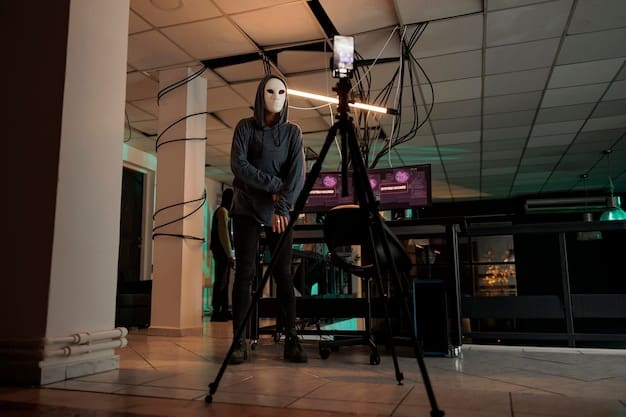Short Film Directing: Guide US Cast & Crew to Powerful Stories

Short film directing involves effectively guiding your cast and crew to translate your vision into a compelling narrative for US viewers, requiring strong leadership, clear communication, and creative problem-solving to overcome budget and time constraints.
Embarking on the journey of short film directing can be both exhilarating and daunting. This guide simplifies the process of guiding your cast and crew to create a impactful story tailored for US audiences, ensuring your vision translates powerfully to the screen.
Understanding the US Audience: Crafting a Relatable Narrative
Before diving into production, grasp what resonates with the US audience. Understanding their cultural nuances and expectations for short films is key. Knowing what they find interesting and meaningful significantly impacts your narrative choices.
A relatable narrative hinges on authenticity and emotional resonance. Consider themes that deeply connect with US viewers and adapt your story to emphasize these connections.
Identifying Universal Themes
To create a story with broad appeal, focus on themes that resonate across different demographics. This helps ensure your short film will connect with a larger segment of the US audience.
- Family Dynamics: Exploring complex relationships within families is always a compelling theme.
- Personal Growth: Stories about overcoming obstacles and achieving self-discovery are universally inspiring.
- Social Justice: Addressing relevant social issues can spark important conversations and increase viewer engagement.
By carefully selecting and weaving these elements into your screenplay, you increase the likelihood that your short film will make a lasting impression on US audiences.

Pre-Production: Assembling Your US Cast and Crew
Effective pre-production is crucial for a successful short film. Choosing the right cast and crew is a paramount step in this process. Select individuals who align not only skill-wise but also share your vision.
Finding talent that understands your direction and can bring their expertise to the table is vital. This collective effort ensures a high-quality final product.
Casting Actors for Authentic Performances
Hold auditions and carefully evaluate actors’ ability to embody the characters. US audiences value authenticity, so prioritize actors who connect emotionally with the script.
Look for actors with the range to portray nuanced performances, delivering depth and believability to your story.
Building a Skilled and Collaborative Crew
A technically proficient crew is essential for bringing your vision to life. Choose individuals with a proven track record and a collaborative spirit.
- Cinematographer: Find someone capable of creating visually stunning shots that enhance the narrative.
- Sound Designer: Select a professional who can deliver immersive, high-quality audio to complement the visuals.
- Editor: Partner with an editor skilled in crafting a tight, compelling narrative that keeps the audience engaged.
Each of these roles plays a significant part in shaping the final product, so take the time to assemble a team that can execute your vision flawlessly.
Creating a Shooting Schedule and Budget for US Filmmaking
Short films often operate with limited resources, so a meticulous shooting schedule and budget are essential. Effective planning determines the feasibility and quality of your project. Understanding the financial and time constraints helps optimize resource allocation.
Carefully manage your resources to ensure that every dollar and every minute counts towards achieving your creative objectives.
Developing a Realistic Timeline
Assess each scene’s complexity and allocate sufficient time for shooting. Factor in potential delays and unforeseen challenges in your schedule.
Having a buffer allows you to address issues without jeopardizing the entire production timeline.
Managing the Budget Effectively
Carefully allocate your funds to the most critical areas of production. Prioritize elements that significantly impact the story’s authenticity and visual appeal.
- Equipment Rentals: Secure affordable deals from reputable vendors.
- Location Permits: Ensure all necessary permits are obtained within your budget.
- Post-Production Costs: Allocate funds for editing, sound design, and color correction.
Proper budgeting ensures that your short film remains financially viable without compromising on essential quality aspects.
Directing Actors: Achieving Compelling Performances for US Viewers
Directing actors to elicit compelling performances is a crucial aspect of effective short film directing. Understanding their needs and motivating them to embody their characters is essential for audience connection. Creating a supportive environment empowers actors to deliver their best work.
Foster a collaborative atmosphere where actors feel free to explore their characters and contribute creatively to the storytelling process.
Communication Strategies for Actors
Communicate your vision clearly and provide specific guidance to actors. Share insights into their characters’ motivations, emotions, and background.
Regularly check in with each actor to ensure they are on the right track and address any performance-related concerns promptly.
Creating a Comfortable and Productive Set
Maintain a respectful and professional environment on set. Focus on creating conditions that allow actors to perform without distractions. This includes providing adequate breaks, clear directions, and celebrating successes.
A positive atmosphere can unlock their potential and lead to genuinely affecting performances.

Working with the Crew: Collaboration and Communication on Set
Effective collaboration and consistent communication are essential when working with your crew on set. Clear roles and responsibilities prevent confusion and enhance productivity. A collaborative spirit ensures that everyone is aligned with the vision.
Open communication promotes a positive atmosphere, allowing for smoother problem-solving and efficient decision-making throughout the shoot.
Importance of Clear Roles and Responsibilities
Clearly define each crew member’s role and responsibilities from the outset. Ensure that everyone understands their specific tasks and how they contribute to the overall production.
This reduces the risk of overlaps and gaps in responsibilities, fostering a more efficient workflow.
Effective Communication Techniques
Establish regular communication channels to keep everyone informed about progress, changes, and challenges. Use daily briefings to share updates, address concerns, and coordinate activities.
Promote open dialogue and encourage feedback from crew members, fostering a culture of collaboration and mutual respect.
Post-Production and Distribution: Reaching the US Short Film Market
Solid post-production is essential for preparing your short film for the US market, requiring careful editing, sound design, and color grading. After the film is refined, strategic distribution gets your content in front of audiences. Understanding both enhances visibility and impact.
A carefully executed distribution plan maximizes your chances of reaching the right viewers and achieving film festival selections.
Maximizing Impact Through Editing and Sound
Editing is more than just assembling shots; it’s crafting the rhythm and emotional arc of the film. Sound design fills out the experience beyond the visuals. Focus on creating a finished product that resonates deeply with the US film festival circuit.
- Tight Narrative: An effective edit makes the story accessible and captivating.
- Sound Design: High-quality audio enhances the viewing experience.
Submitting to US Film Festivals
Research and select film festivals that align with your film’s genre and target audience. Prepare a compelling submission package, including a high-quality screener and a well-written synopsis.
A targeted festival strategy maximizes your chances of recognition and success within the US short film community.
| Key Point | Brief Description |
|---|---|
| 🎯 Audience Analysis | Understand US viewers’ interests to craft a relatable story. |
| 🎬 Casting & Crew | Assemble a skilled team that aligns with your vision. |
| ⏱️ Budget & Schedule | Plan resources meticulously for efficient production. |
| 📣 Communication | Maintain clear dialogue with cast and crew for seamless workflow. |
FAQ
▼
Common pitfalls include not providing clear direction, failing to give timely feedback, and neglecting to create a comfortable environment. Over-directing can also stifle creativity.
▼
Understanding cultural nuances, societal issues, and storytelling preferences are essential. Research what kinds of stories are currently popular in the US and tailor your narrative accordingly.
▼
Most film festivals prefer short films that are 20 minutes or less. Shorter films often have a higher chance of being selected due to limited screening time and diverse content selection.
▼
Sound design is essential for creating a compelling and immersive viewing experience. High-quality audio can significantly enhance the emotional impact and overall quality of a film, complementing the visuals beautifully.
▼
Distribution costs vary. Film festival submissions can range from $25 to $100 per festival. Marketing, promotional materials and hiring a distributor can also add costs, depending on the strategy.
Conclusion
Mastering the art of short film directing involves blending creativity with strategic planning to create a compelling and impactful story for US viewers. By focusing on audience relevance, assembling a skilled team, and managing resources effectively, you can craft a short film that resonates deeply and achieves success on the US film festival circuit.





